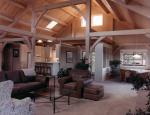Search engine visitors - click here to access entire "$ensible Home" web site
Click here to see a descriptive illustration showing several interior and exterior views of a timber-framed home.
Dear Jim: You recently wrote about steel-framed houses, but aren't timber-framed houses also strong and efficient? What is the best method to build a contemporary timber-framed home for efficiency and high strength? - Ed A.

A: You are correct that timber-framed houses are very strong. This construction method was commonly used centuries ago in Europe and many of the houses are still being used. When this proven building method is merged with new construction materials, these homes are very efficient and strong.
Although strength and efficiency are important, the unique open architecture, huge exposed timbers, high cathedral ceilings and lofts are the features that sell these homes. When you are in one, you can't help but sense the quality and beauty of the hand-fit and finished natural timbers.
Timber-framed houses are a subset of post-and-beam houses. In all these houses, the frames are made of massive timbers. Timber framing is unique in that the individual timbers are connected by pins and mortise-and-tenon joints. Experienced craftsman carve and fit each joint and pin by hand.
For high energy efficiency, the exterior of a timber-framed house is often made of insulated foam core panels. These large lightweight panels have high insulation levels and fit together with seals and lap joints. This provides a continuous super-insulated envelope and airtight joints.
Another efficiency advantage is the high thermal mass of the huge exposed timbers. This thermal mass tends to moderate indoor temperature swings throughout the day as the outdoor temperature changes. This is particularly effective to reduce cooling costs and improve comfort during the summer.
Since you want unique, contemporary styling, choose an open floor plan with tall windows facing south in a room with a high cathedral ceiling. This is ideal of free passive solar heating. Include a stone or masonry fireplace, perhaps two-sided, with a tall masonry chimney in the center of the room. This will be efficient and also an attractive centerpiece of the room.
There are various framing techniques (common rafter, hammer beam, king post, queen post, etc.) which your timber framer can use. They all are strong so base your decision on the aesthetics. If you like a rustic appearance, choose oak, pine or hemlock. Douglas fir has a smoother, crisper look.
Timber-framing is not inexpensive and consumes much wood, but remember the house will still be standing in 200 years. It is possible to build a hybrid house that uses the beautiful timber framing in a main room or two and a lower-cost construction method for the remaining rooms. A good method is SIPS (structural insulated panels) that support themselves with no framing.
Instant Download Update Bulletin No. 518 - list of 18 timber-frame house manufacturers and builders across the U.S., seven exterior diagrams/floor plan layouts of unique houses -1,400 sq. ft. to 4,300 sq. ft., illustrations of the timber framing, and specifications on some of the homes.
Dear Jim: We just switched to a gas water heater from an electric one. I used to drain the tank a little about four times per year to remove sediment. Is this still necessary with a gas water heater? - Sally F.
A: It is important to keep the water heater tank clean of sediment to realize its highest efficiency. This is actually more important for a gas water heater than for an electric one so keep doing it.
Much of the heat from a gas burner comes from direct heat transfer through the bottom of the water heater tank. This is also where sediment will build up. On an electric water heater, the heater element is above the tank base.